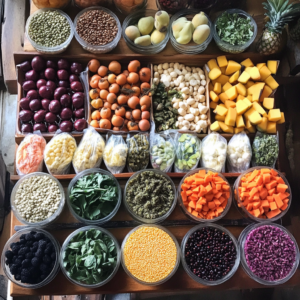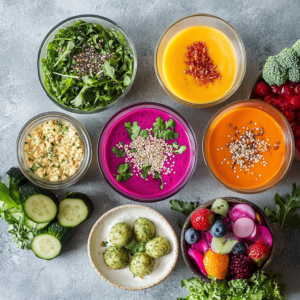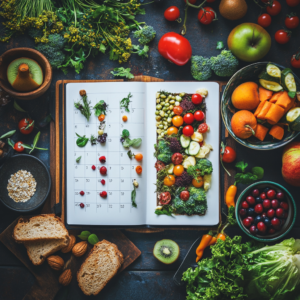Introduction
Welcome, fellow health enthusiasts! In this guide, I am excited to introduce you to the importance of fiber in a vegan diet and show you how to incorporate it effectively for optimal wellness. Right from the start, my focus is on a fiber in vegan diet approach—ensuring that every meal is enriched with the essential fiber that supports digestion, satiety, and overall health. I discovered early on that fiber in a vegan diet is the cornerstone of a healthy, plant-based lifestyle, providing vital support for digestion, aiding in weight management, and contributing to improved heart health. Whether you are new to veganism or looking to refine your eating habits, understanding the role of fiber in a vegan diet will empower you to make informed, nutritious choices every day.
If you’d like more creative meal ideas to complement your fiber-rich plan, please visit our article Quick and Delicious Vegan Recipes for Busy Weeknights. Additionally, for an external perspective on healthy eating, you can explore the guidelines at Nutrition.gov.
1. What Is Fiber and Why Is It Essential in a Vegan Diet?
Dietary fiber is a type of carbohydrate found only in plant foods that the body cannot digest. Its passage through the digestive system offers a range of benefits without being absorbed, making fiber in a vegan diet a critical component for maintaining overall health.
a. Definition of Dietary Fiber in a Vegan Diet
Fiber comes primarily in two forms: soluble fiber, which dissolves in water to form a gel-like substance that helps lower cholesterol and blood sugar levels, and insoluble fiber, which adds bulk to stool and aids in regular bowel movements. Both forms are integral to a vegan diet to ensure digestive health and overall wellness.
b. Soluble vs. Insoluble Fiber in a Vegan Diet
While soluble fiber supports heart health and stabilizes blood sugar levels, insoluble fiber is essential for preventing constipation. Including both types in your fiber in vegan diet ensures a full range of benefits that contribute to a balanced and healthy digestive system.
2. Health Benefits of Fiber in a Vegan Diet
A diet rich in fiber provides extensive health benefits beyond improved digestion.
a. Promoting Digestive Health and a Balanced Gut Microbiome
Fiber acts as the primary fuel for beneficial gut bacteria. When you consume plenty of fiber in your vegan diet, you promote the growth of these healthy microorganisms, which enhance digestion and support your immune system. A balanced gut microbiome, nourished by fiber, helps reduce inflammation and lowers the risk of various chronic conditions.
b. Enhancing Satiety and Supporting Weight Management
High-fiber foods slow down the digestion process, helping you feel fuller for longer. This increased satiety reduces the likelihood of overeating and supports weight management—making fiber in a vegan diet an effective ally in your weight loss journey.
c. Regulating Blood Sugar and Lowering Cholesterol
Fiber helps stabilize blood sugar by slowing the absorption of glucose into the bloodstream. Soluble fiber also binds to cholesterol, reducing its uptake and supporting cardiovascular health. These mechanisms underline the importance of fiber in a vegan diet for a healthy metabolism.
d. Supporting Immune Function and Reducing Inflammation
The fermentation of fiber by gut bacteria produces short-chain fatty acids, which have anti-inflammatory properties and support immune function. This further emphasizes how fiber in a vegan diet contributes to long-term health and disease prevention.
3. Top Sources of Fiber for a Vegan Diet
One of the great advantages of a vegan lifestyle is the abundance of fiber-rich foods available naturally.
a. Fiber-Rich Fruits and Vegetables
Fruits such as apples, pears, berries, and bananas, along with vegetables like broccoli, carrots, and leafy greens, are excellent sources of both soluble and insoluble fiber. These foods support digestion while providing essential vitamins and antioxidants.
b. Whole Grains and Legumes
Whole grains like brown rice, quinoa, oats, and barley, as well as legumes such as lentils, chickpeas, and black beans, are powerful sources of fiber. They provide sustained energy and aid in maintaining healthy blood sugar levels, forming the backbone of a fiber in vegan diet.
c. Nuts, Seeds, and Other Plant-Based Foods
Almonds, walnuts, chia seeds, flaxseeds, and hemp seeds not only supply fiber but also deliver healthy fats and protein. Incorporating these foods into your meals can boost the fiber content of your vegan diet in a delicious and versatile way.
d. Superfoods for an Extra Fiber Boost
Superfoods like kale, spinach, blueberries, and acai berries are both nutrient-dense and high in fiber. They can be easily added to smoothies, salads, or used as toppings, ensuring your fiber in vegan diet is both varied and potent.

4. Practical Tips to Increase Fiber Intake in a Vegan Diet
Optimizing fiber consumption is simple with the right strategies, and it’s essential for achieving the benefits of a fiber-rich vegan diet.
a. Meal Planning Strategies for a High-Fiber Vegan Diet
Plan your meals around high-fiber ingredients to ensure you consistently meet your fiber needs. I recommend starting with fiber-loaded breakfasts like overnight oats or green smoothie bowls. For lunch and dinner, include a variety of vegetables, legumes, and whole grains. A weekly meal plan can simplify grocery shopping and ensure a steady intake of fiber.
b. Cooking Techniques to Preserve Fiber Content
Gently cooking your food can help preserve its fiber content. Techniques such as steaming, baking, and roasting maintain the natural fiber found in fruits and vegetables. Avoid overcooking, which may diminish fiber levels, so you continue to benefit from a fiber-rich vegan diet.
c. Reading Nutrition Labels to Monitor Fiber
Always check nutrition labels when purchasing food products, particularly processed items, to ensure they contribute adequately to your fiber in a vegan diet. This habit is a key part of maintaining your daily fiber intake.

5. Sample High-Fiber Vegan Meal Plan
Here’s a sample meal plan designed to maximize fiber intake while ensuring balanced nutrition in your vegan diet.
a. High-Fiber Vegan Breakfast Ideas
- Overnight Oats with Chia and Berries: Mix rolled oats, almond milk, chia seeds, and a dash of maple syrup. Top with fresh berries and banana slices for a breakfast rich in fiber and energy.
- Green Smoothie Bowl: Blend spinach, frozen banana, avocado, and coconut water until smooth, then top with granola, kiwi slices, and flaxseeds.
b. Nutritious High-Fiber Vegan Lunch Options
- Quinoa and Black Bean Salad: Combine cooked quinoa with black beans, chopped bell peppers, and cherry tomatoes. Toss with a cilantro-lime vinaigrette for a satisfying, fiber-packed meal.
- Veggie-Packed Wrap: Use a whole grain wrap filled with hummus, shredded carrots, mixed greens, cucumber slices, and avocado for a portable, fiber-rich option.
c. Satisfying High-Fiber Vegan Dinner Recipes
- Stir-Fried Tofu and Vegetables: Sauté tofu with broccoli, bell peppers, snap peas, and carrots in a light soy-ginger sauce; serve over brown rice or quinoa to ensure a balanced, fiber-rich meal.
- Vegan Lentil Stew: Prepare a hearty stew with red lentils, diced tomatoes, spinach, carrots, and celery, seasoned with herbs and spices for a warming, fiber-dense dinner.
d. Fiber-Rich Snacks and Smoothies
- Energy Balls: Blend dates, oats, almond butter, and cocoa powder into bite-sized treats that deliver both fiber and protein.
- Fresh Fruit and Nut Mix: Combine sliced apples, grapes, almonds, and walnuts for a quick, nutrient-rich snack.
- Veggie Sticks with Hummus: Enjoy crunchy carrot, cucumber, and bell pepper sticks with a serving of homemade hummus for a refreshing snack that boosts fiber intake.

6. Overcoming Challenges with Fiber in a Vegan Diet
While increasing fiber is highly beneficial, it can sometimes lead to challenges such as gas, bloating, or difficulty balancing fiber with other nutrients. Here are some strategies that have helped me navigate these issues:
a. Managing Gas and Bloating
A sudden increase in fiber can cause discomfort, so I recommend gradually upping your fiber intake to allow your digestive system to adjust. Drinking plenty of water and including probiotic-rich foods like sauerkraut or kimchi can also help ease digestion.
b. Balancing Fiber with Other Nutrients
It’s essential to maintain a balanced diet by ensuring that your fiber intake is complemented by sufficient protein, healthy fats, and micronutrients. Keeping a food diary and monitoring your body’s response has helped me fine-tune my diet, making it easier to enjoy a fiber-rich vegan diet without compromising overall nutrition.
7. Additional Resources and Tools for a Fiber-Rich Vegan Diet
To dive deeper into the benefits and techniques of incorporating fiber into your plant-based eating plan, explore the following resources:
• For more creative ideas on plant-based recipes, check out our article Quick and Delicious Vegan Recipes for Busy Weeknights.
• Learn practical budgeting tips for healthy eating at Budget-Friendly Vegan Meals That Don’t Sacrifice Taste.
• For further reading on nutritional guidelines, visit Nutrition.gov and explore peer-reviewed research on PubMed.
For those interested in obtaining more information on this topic, we recommend this complete course which covers several interesting topics related to veganism.
8. Frequently Asked Questions (FAQ) About Fiber in a Vegan Diet
Common Queries Answered
Q1: What exactly is dietary fiber, and why is it important?
A1: Dietary fiber is a type of carbohydrate that the body cannot digest. It promotes digestive health, stabilizes blood sugar levels, and supports satiety, all of which are crucial for a healthy vegan lifestyle.
Q2: How can I incorporate more fiber into my daily meals?
A2: Increase your fiber intake by including a variety of fruits, vegetables, whole grains, legumes, nuts, and seeds. Experimenting with new recipes can help you consistently meet your fiber goals.
Q3: Are there any side effects to increasing fiber too quickly?
A3: Yes, a sudden increase in fiber can cause gas, bloating, and discomfort. It is best to gradually increase your intake and drink plenty of water to allow your digestive system to adjust.
Q4: Can a fiber-rich diet help with weight management?
A4: Absolutely. High-fiber foods promote satiety, which can help control appetite and reduce overall calorie intake—key factors in effective weight management.
Q5: What are some quick sources of fiber for busy days?
A5: Fresh fruits, raw vegetables, pre-made salads, energy balls, and whole grain snacks are all convenient options that help ensure your fiber intake remains consistent even on hectic days.
Q6: How do I balance fiber intake with other nutrients?
A6: Careful meal planning and the use of nutrition labels can help you maintain a balanced diet by ensuring that your fiber intake is complemented by sufficient protein, healthy fats, and essential micronutrients.
9. Conclusion and Final Thoughts
In conclusion, understanding and incorporating fiber in a vegan diet is essential for achieving optimal digestive health, sustained energy, and overall wellness. A well-planned, fiber-rich vegan diet supports weight management, a balanced gut microbiome, and even better heart health by regulating blood sugar and lowering cholesterol. By focusing on whole, nutrient-dense foods and employing effective meal planning strategies, you can seamlessly integrate fiber into your daily routine and enjoy its many benefits.
My journey in embracing a high-fiber vegan diet has taught me the value of gradual changes, smart grocery shopping, and creative meal planning. Every carefully crafted meal is a step toward better health and a more sustainable lifestyle. I hope this comprehensive guide on The Role of Fiber in a Vegan Diet: Benefits and Sources has inspired you to explore new fiber-rich recipes and adopt strategies that enhance your overall wellness.
If you’re ready to take your plant-based nutrition to the next level and discover even more innovative recipes and tips, I invite you to explore our other resources and join our community. Your commitment to a fiber-optimized vegan diet will not only transform your digestive health but also enrich your life with vitality, wellness, and a deeper connection to the natural foods that nourish your body.